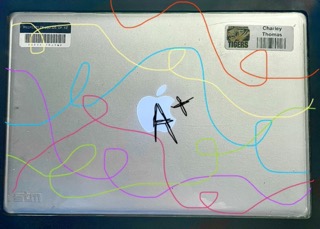Close the Computer Lid
Technology in schools comes with some significant drawbacks

If I had to take a wild guess, I would speculate that this opinion piece isn’t the first you’ve stumbled upon with the keywords “digital” and “education” in the article. Frankly, the topic is a little tired with regards to the whole “COVID-19 changed the way we do school” narrative, but this story isn’t entirely about that. Even before the era of online school, technology was being pumped into schools and distributed to students of all ages with the central aim of facilitating the educational process and preparing the next generation for a rapidly evolving world. News outlets and district leaders raved about the influx of efficiency, but the digital shifts brought some rain in addition to the sunshine and rainbows the techies preached. My disclaimer for this piece is as follows: of course there are many benefits of incorporating online aspects into school — that’s why we do it. It can help teachers and students stay organized, simplify formerly tedious tasks, and acclimate students to modern professionalism. However, the system still has a great deal of drawbacks, and I’ve pointed out a few of the major ones down below.
You’re always connected
To some, this statement comes off positively — you’re never more than a click away from your studies. To me, that’s the problem. Work-life balance is a skill in and of itself, and constant access to grades, agendas, and upcoming assignments diminishes the barrier between school and home. When I’m finally finished with school, practice, other activities, and homework, my MacBook is always there to remind me that there’s another project I should get a head start on, another quiz on the calendar, and another test grade published to jack up my heart rate. The nonstop educational information is much like that of the recent news media phenomenon people have already identified as a major issue — when we’re bombarded with current events coverage at all times, it becomes increasingly difficult to prioritize and focus on our personal lives. Yes, students need to know what’s going on. No, students do not need to receive an update at 9:54 p.m. on a Tuesday about what’s happening two weeks from now. Sometimes this digital connection could be a little less connected, giving students and teachers alike more room to breathe.
Faux-Flexibility
One major talking point for pro-tech teachers, district leaders, and presumably whoever made Canvas is that online systems grant everyone flexibility. They argue that by posting agendas and moving paper activities to laptops, work can be done anywhere, anytime. Sounds flexible, right? In reality, it has the opposite effect. When students were absent for sports tournaments, family events, or even school-enacted snow days in the past, conversations were had upon their return about how to catch up on work. If you were gone, you were gone, and you could complete what you needed to once you were back. Nowadays, our due dates are digital — time stamped and able to be enforced anywhere, anytime. Earlier this year, I was at lunch on a snow day when I received a panicked text from a classmate about how our assignment, which we were supposed to do and turn in that day in class, was in fact still due in an hour. We had no access to our teacher and were not in the building that day as per the district’s wishes, but we were still expected to use this “flexible” system to do everything ourselves. Call me a complainer, but that’s beyond unreasonable. Under this pseudo-flexibility, kids are punished for unexpected events like snow days and unrealistically expected to be attached to their devices at all times in case of an online assignment-attack. In my opinion, some olden-days conversations between teachers and students need to make a comeback. The world will not end if my geometry assignment gets finished two days later than Canvas intended. A computer doesn’t understand that sometimes life happens, but the people behind them should, and they need to adjust accordingly.
Just because you can, doesn’t mean you should
Perhaps my most obvious critique of all is my general distaste for typing away on my computer all day. MacBooks are great for technology classes, creating presentations, and researching on the internet. You know what doesn’t need to be on computers all the time? Annotating, collaborative projects, every in-class assignment, and, most of all, the lectures themselves. There’s nothing more isolating and unengaging than showing up for an in-person class only for the day’s agenda to be watching a pre-recorded video of a teacher then doing an assignment completely individually on the computer. Generally speaking, if the entire lesson can take place without instruction or interaction of any kind, we’re butchering the learning process. I understand that there are absolutely times when video lessons or other digital activities are warranted, but let’s not overdo it. When we lean too heavily upon our screens, we lose sight of the value of teachers and student collaboration — the two aspects, I would argue, that serve as the strongest arguments for why we need school in the first place.
Technology is helpful, but only if we know how and when to use it. The reason this “innovational age” of education sounds too good to be true at times is because it is. Every rose has its thorns, and the thorns of digital learning must be discussed if education is to fulfill its aims.

Charley Thomas is a senior and serves as Editor-in-Chief of the Tiger Print this year. At BV, she is a member of the Varsity Volleyball Team, Student Council,...



